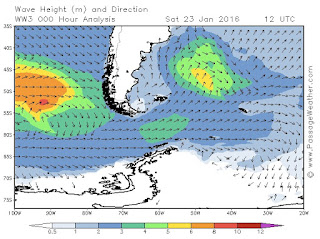On January 10 we stopped at Portal Point. This is where we stepped ONTO THE CONTINENT!!! Exclamations because it is supposed to be a big deal, we had only visited Antarctic islands previous to this.
The interesting thing about this place is that it is one of the very few places you can get onto the continent. Antarctica is covered by a very thick ice sheet and for thousands upon thousands of miles around its shores, there are ice cliffs hundreds of feet tall, forming an impenetrable barrier. This is one of the places where the ice forms a walkable ramp to the sea, thus many people access the continent here.
After hanging out on the glacier, we went back to the ship for what I am calling the Antarctic baptism. I have done this in every remote place I've been. In the past it involved a bath in a glacial stream which I did in the Andes and Himalayas. This one was diving into the Antarctic Ocean from the ship. The water was 33 degrees, just above freezing. About half of the passengers did it. Everyone said I looked very casual and relaxed but the only thing that went through my mind after I hit the water was GET OUT! The ship has a sauna and that's where everyone ended up who jumped in. I have a pic but it will have to wait...
After the Polar Plunge, we visited many places, sometimes two or three per day, and observed wildlife. Two interesting sites, the Lemaire Channel, a narrow channel with very steep sides and filled with icebergs, and a sailboat at Port Lockroy.
We passed through the Lemaire starting at midnight, which is just dusk that far south in January. This was our farthest southern point, about 1 degree north of the Antarctic Circle. They woke everyone up to get pics of this passage. The next day we visited Port Lockroy, which has an occupied British science station, but the interesting site was a small sailboat. They had sailed from Ushuaia, same as us, and the boat had no special hull. It was fiberglass, not steel. Plus it was pretty small, less than 50 feet. Not sure I would sail the Drake like this, but there they were.
Leopard seal hanging out on an iceberg. They eat penguins.
Me on the Continent!
Midnight in the Lemaire Channel
A sailboat at Port Lockroy






































